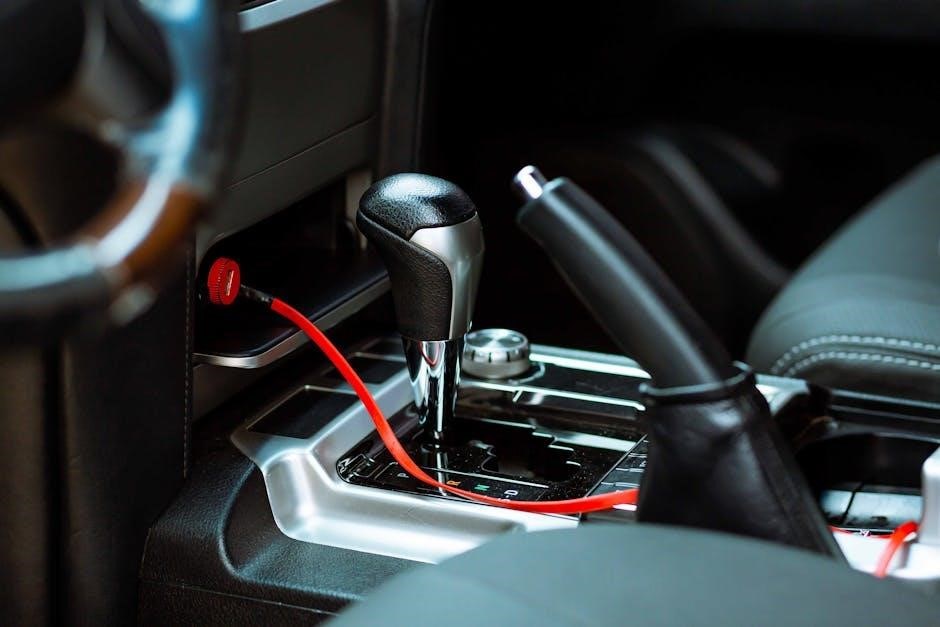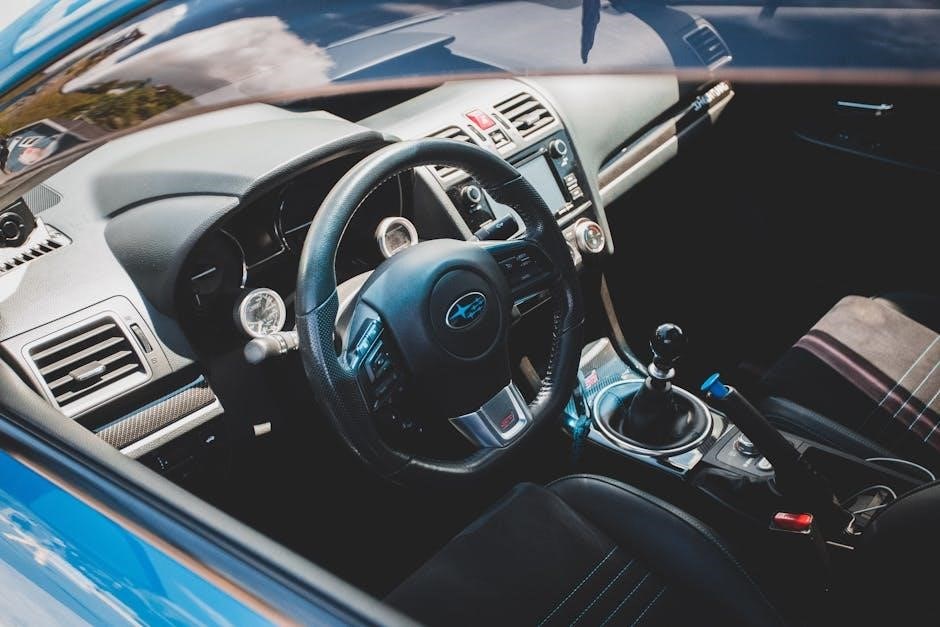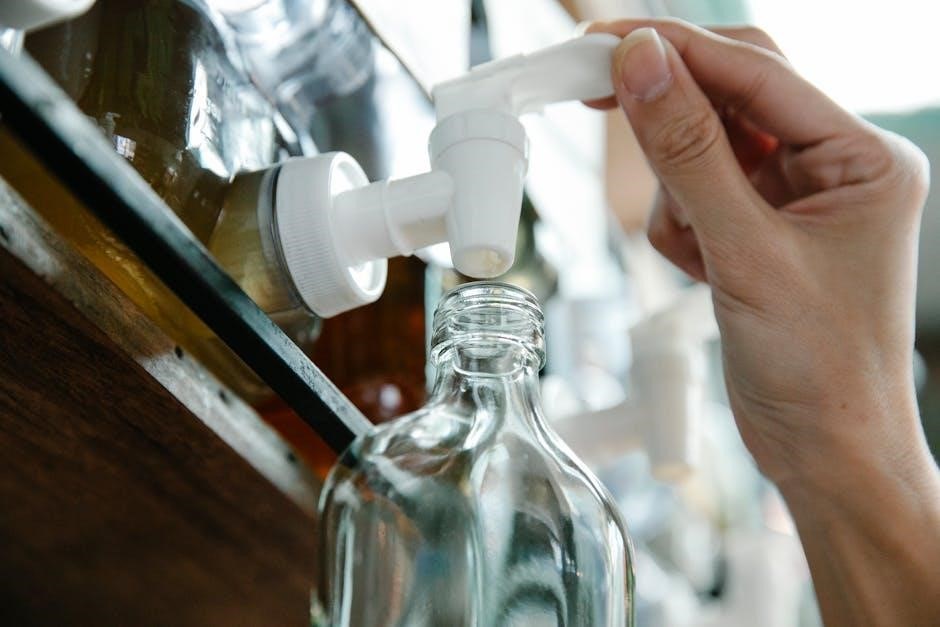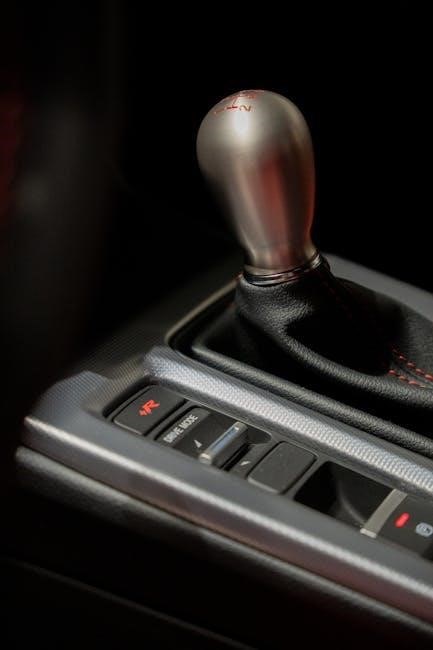Importance of Manual Transmission Fluid in Subaru Vehicles
The manual transmission fluid is critical for ensuring smooth gear operation, reducing friction, and preventing overheating in Subaru vehicles. It lubricates gears, bearings, and synchronizers, extending their lifespan. Regular maintenance prevents corrosion and ensures optimal performance.
1.1 Why Transmission Fluid is Critical for Subaru’s Performance
Transmission fluid is essential for Subaru’s performance as it lubricates gears, bearings, and synchronizers, ensuring smooth and precise shifting. It also manages heat generated by friction, preventing overheating and damage. The fluid protects against corrosion and wear, maintaining the integrity of moving parts. Without proper lubrication, gears can grind, leading to costly repairs; Regular fluid maintenance ensures optimal performance, reliability, and longevity of the manual transmission system in Subaru vehicles.
1.2 How Transmission Fluid Affects Gear Functionality and Longevity
Transmission fluid plays a crucial role in maintaining gear functionality by reducing friction and preventing wear on moving parts. It ensures smooth engagement and disengagement of gears, minimizing the risk of grinding or slipping. Over time, degraded or low fluid levels can lead to increased wear, corrosion, and overheating, which shortens the lifespan of gears and bearings. Proper fluid levels and quality are essential for maintaining the durability and performance of Subaru’s manual transmission system, ensuring reliable operation for years to come.

Recommended Transmission Fluid for Subaru Manual Transmissions
Subaru’s OEM transmission fluid is highly recommended for optimal performance. Aftermarket options like Valvoline 75W/90 are also compatible and offer excellent lubrication and gear protection.
2.1 Subaru OEM Transmission Fluid: Features and Benefits
Subaru’s OEM transmission fluid is specifically formulated to meet the unique demands of Subaru manual transmissions. It provides superior lubrication, reduces friction, and protects against wear and tear. The fluid is designed to maintain optimal viscosity under various temperatures, ensuring smooth gear shifts. It also contains anti-corrosion additives to protect internal components and is fully compatible with Subaru’s manual transmission systems. Using OEM fluid ensures reliability and adherence to Subaru’s engineering standards, making it the best choice for maintaining performance and longevity.
2.2 Compatible Aftermarket Fluids: Valvoline 75W/90 and Others
Aftermarket options like Valvoline 75W/90 are popular alternatives for Subaru manual transmissions. These fluids meet the GL-5 specification and provide excellent lubrication and wear protection. Valvoline’s formulation is synthetic blend, offering improved thermal stability and fuel efficiency. Other compatible fluids include synthetic 75W/90 options, which also reduce gear clash and maintain smooth operation. While they may not be OEM, these aftermarket fluids are cost-effective and high-quality, making them viable choices for Subaru owners seeking reliable performance without the premium price of OEM products.

How to Check Manual Transmission Fluid Level in Subaru
To check the manual transmission fluid level in your Subaru, locate the dipstick under the hood or near the transmission. Ensure the vehicle is on level ground and the engine is warm. Pull out the dipstick, wipe it clean, and insert it back to get an accurate reading. The fluid level should be between the minimum and maximum marks on the dipstick.

3.1 Locating the Transmission Dipstick in Subaru Models
In Subaru models with a manual transmission, the dipstick is typically located near the transmission or engine area. For most models, such as the Forester or Crosstrek, it can be found by opening the hood and looking toward the driver’s side. Some models may require consulting the owner’s manual for precise location, as it can vary slightly by year and trim. Always ensure the vehicle is on level ground before checking the dipstick for accurate fluid level readings.
3.2 Step-by-Step Process for Checking Fluid Level
To check the manual transmission fluid level in Subaru models, start by warming up the engine with a short drive. Locate the transmission dipstick, as described earlier, and pull it out. Wipe it clean with a lint-free cloth and reinsert it to get an accurate reading. Pull the dipstick again and check the fluid level by looking at the end. The level should be between the “MIN” and “MAX” marks. If low, add the recommended fluid type. Always refer to the owner’s manual for specific guidance.

Signs of Low or Degraded Transmission Fluid

Common symptoms include slipping gears, the check engine light illuminating, and abnormal noises during gear shifts. Low fluid levels can also cause hesitation or rough shifting.
4.1 Common Symptoms: Slipping Gears, Check Engine Light, and More
When transmission fluid is low or degraded, Subaru vehicles often exhibit slipping gears, causing inconsistent acceleration. The check engine light may illuminate, indicating transmission-related issues. Additional symptoms include abnormal noises, such as clunking or whining during gear shifts, and delayed engagement of gears. In severe cases, the transmission may hesitate or fail to shift smoothly, leading to reduced performance and potential damage. These signs necessitate prompt inspection and fluid level checks to prevent further complications.

Changing Manual Transmission Fluid: A Step-by-Step Guide

Changing manual transmission fluid involves draining the old fluid and refilling with the recommended Subaru OEM or compatible aftermarket fluid to ensure smooth operation.
5.1 Tools and Materials Needed for Fluid Replacement
To replace the manual transmission fluid in your Subaru, you will need a socket wrench, a drain pan, new transmission fluid (Subaru OEM or compatible aftermarket), a funnel, rags, and safety gloves. Additional tools may include a car lift or jack for better access and a new transmission filter if recommended. Ensure the fluid meets the specified 75W/90 viscosity rating for optimal performance. Having all materials ready beforehand ensures a smooth and efficient fluid replacement process.
5.2 Proper Procedure for Draining and Refilling Fluid
Start by warming the engine with a short drive to ensure the fluid drains easily. Park on a level surface and engage the parking brake. Locate the transmission drain plug underneath the car, typically near the front of the transmission pan. Use a socket wrench to loosen and remove the plug, allowing the fluid to drain into a pan. Once drained, replace the plug securely. Refill the transmission with the recommended fluid, using a funnel to prevent spills. Check the fluid level by inserting the dipstick or consulting the owner’s manual. Dispose of the used fluid responsibly and wash your hands thoroughly.

Maintenance Schedule for Subaru Manual Transmission Fluid
Subaru recommends changing the manual transmission fluid every 30,000 to 60,000 miles, depending on driving conditions. Severe service, such as frequent towing or extreme temperatures, may require more frequent changes. Regular fluid replacements help maintain optimal gear performance and prevent premature wear. Always refer to the owner’s manual for specific guidelines tailored to your vehicle’s needs.
6.1 Subaru’s Official Recommendations for Fluid Changes
Subaru officially recommends changing the manual transmission fluid every 30,000 to 60,000 miles, depending on driving conditions. For vehicles under normal driving conditions, the fluid should be replaced at 60,000-mile intervals. However, for severe service, such as frequent towing, extreme temperatures, or off-road driving, the fluid should be changed more frequently, typically every 30,000 miles. Subaru also specifies using GL-5 certified 75W/90 gear oil, which is compatible with their manual transmissions. Adhering to these guidelines ensures optimal performance and longevity of the transmission system.
6.2 Severe Service Conditions That Require More Frequent Changes
Severe service conditions, such as frequent towing, extreme temperatures, or off-road driving, necessitate more frequent manual transmission fluid changes in Subaru vehicles. These conditions generate excessive heat and stress, accelerating fluid degradation. Additionally, driving in dusty environments or carrying heavy loads can introduce contaminants, reducing fluid effectiveness. Subaru recommends changing the fluid every 30,000 miles under such conditions to maintain optimal transmission performance and prevent premature wear. Regular monitoring and timely fluid replacement are crucial for ensuring the longevity and reliability of the manual transmission system.

Frequently Asked Questions About Subaru Manual Transmission Fluid
Common questions include whether non-OEM fluids are suitable and how often to check fluid levels. Answers emphasize using OEM fluids for optimal performance and checking levels regularly to prevent damage and ensure smooth operation.
7.1 Can I Use Non-OEM Fluid in My Subaru Manual Transmission?
While aftermarket options like Valvoline 75W/90 are compatible, Subaru recommends using OEM fluid for optimal performance and warranty compliance. Non-OEM fluids may void warranties or cause issues, as they might not meet Subaru’s specific requirements. Using approved fluids ensures reliability and longevity of your transmission. Always consult your owner’s manual or a Subaru specialist for verified alternatives.
7.2 How Often Should I Check the Transmission Fluid Level?
It is advisable to check the transmission fluid level in your Subaru during regular maintenance intervals, typically every 5,000 to 7,500 miles, or as specified in your owner’s manual. Additionally, if you notice symptoms such as the check engine light illuminating or gears slipping, you should inspect the fluid level immediately. For vehicles subjected to severe driving conditions, such as frequent towing or extreme temperatures, more frequent checks are recommended to ensure optimal transmission performance and longevity.